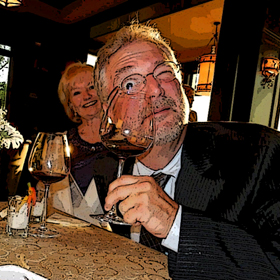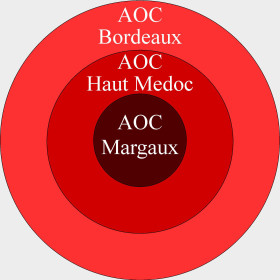A Look At French Wine Laws
Chapter Sixteen, Part Two.
 France has hundreds of wine appellations that are broken down into three quality levels; Appellation d’Origine Contrôlée (AC or AOC), Vin de Pays (VdP), and Vin de Table (VdT). These designations are controlled by the Minister of Agriculture, under the auspices of the Institut National de l’Origine et de la Qualité. Rather than adopt the logical acronym INOQ, the organization retained an earlier acronym INAO (for Institut National des Appellations d’Origine) so they wouldn’t have to replace the stationary.
France has hundreds of wine appellations that are broken down into three quality levels; Appellation d’Origine Contrôlée (AC or AOC), Vin de Pays (VdP), and Vin de Table (VdT). These designations are controlled by the Minister of Agriculture, under the auspices of the Institut National de l’Origine et de la Qualité. Rather than adopt the logical acronym INOQ, the organization retained an earlier acronym INAO (for Institut National des Appellations d’Origine) so they wouldn’t have to replace the stationary.
AOC is AOK
Appellation d’Origine Contrôlée sits at the top of the French quality hierarchy and is the equivalent of the EU designation PDO. This level has the strictest, and therefore highest, quality standards. Some regions, such as Bordeaux and Burgundy, may grant a large area AOC status while simultaneously giving AOC designations to smaller, more esteemed districts within that region. For example, all wines produced in Bordeaux fall under the generic “AOC Bordeaux” appellation, but smaller districts or communes within AOC Bordeaux may also qualify for more prestigious designations such as “AOC Haut Medoc” or “AOC Margaux”.
Typically smaller appellations located within larger AOCs represent higher quality wines and more prestigious estates. I’m a visual learner so I like to  visualize these appellations as a dart board, with the smaller, higher quality appellations nestled within the larger ones. Wineries located within two or more AOCs may opt to use any of the qualifying designations. It isn’t very common, but a winery may downgrade the AOC on its label for wine produced in an inferior vintage.
visualize these appellations as a dart board, with the smaller, higher quality appellations nestled within the larger ones. Wineries located within two or more AOCs may opt to use any of the qualifying designations. It isn’t very common, but a winery may downgrade the AOC on its label for wine produced in an inferior vintage.
AOC regulations cover the following boring part of this article:
• Production Area – AOC demarcated growing areas are very specific and may encompass an entire region, a small village, or a specific vineyard.
• Grape Variety – The types of grapes allowed in an AOC are stipulated to protect the traditional grape varieties of a region although it’s becoming more common for non-native varietals to be included. These regulations may also specify the blending ratio of different grapes varieties.
• Vineyard Practices – This may include how dense the vines are planted, how they are trellised and pruned, harvesting techniques and even the age of the vines.
• Yields – Reducing yields through grape pruning concentrates the vigor of the plant in the remaining grape clusters and produces better results for wine production. The maximum allowable yield is established for each appellation and measured as hectoliter per hectare.
• Alcohol and Ripeness – The measurement of sugar in the unfermented grape juice (measured as must weight) is controlled, as is the minimum alcohol strength.
• Winemaking Practices – Production methods specific to each region are regulated and may include minimum aging requirements.
Appellation d’Origine Contrôlée wines are identified on the label by the term Appellation name of region Contrôlée (e.g. Appellation Beaujolais-Villages Contrôlée), or name of region Appellation Contrôlée (e.g. Sancerre Appellation Contrôlée).
Vin de Pays, Vin de Table, or Vin Diesel
Vin de Pays is a more lenient classification that corresponds with the PGI category in the EU. Since the regulations for Vin de Pays wines are less restrictive than AOC laws, winemakers have more choices in grape variety, yields and vineyard sites. So lax are the regulations that VdP winemakers are even allowed to wear white after Labor Day.
These relaxed regulations coupled with the reduced cost of doing business in VdP regions results in more affordable wines for consumers. Even though VdP appellations are not micromanaged as they are in AOC vineyards, the VdP designation still assures consumers of a wine’s provenance.
Perhaps the most significant benefit to American consumers, who are accustomed to buying wine by the type of grape, is the ruling that VdP wines can be labeled with a varietal name such as Merlot or Chardonnay. If a VdP wine lists a varietal on the label, the wine must be comprised of at least 85% of that varietal. If two varietals are listed, they must comprise 100% of the wine. To find wines in this category look for those labeled Vin de Pays name of region (e.g. Vin de Pays d’Oc).
Vin de Table is what you call a wine that doesn’t meet the quality standards of AOC, VdP or AWS (Arrogant Wine Snobs). This is the least restrictive category and the production, as well as the quality, has faltered in recent decades. Put it this way; if you expect a VdT wine to suck, you won’t be disappointed. Vin de Table wines carry no indication of the grape variety, vintage, or even the region. The central provision for VdT wines is that they be produced entirely from grapes grown somewhere in this solar system. Okay, that’s an exaggeration; actually VdT wines must be produced within the confines of the European Union, which includes swamplands, diesel truck stops and nuclear waste sites.
Much of the Vin de Table wine is light, simple and inferior in quality (just like my writing), but of course there are always exceptions to the rule. In the 1970s, innovative Tuscan winemakers created exceptional wines from unauthorized grape varieties. This isn’t really illegal. No one was arrested or sentenced to two years in new French oak or anything like that. But legal guidelines dictated that these experimental wines be classified under the lowly VdT (Vino di Tavola) designation. It turned out these unconventional wines were anything but simple and inferior, and eventually they became known as “Super Tuscans”. In due time these far-thinking winemakers and their non-conformist wines inspired sweeping changes in the Italian classification system.
If That Ain’t Enough to Remember
The best properties in Bordeaux, Burgundy, Alsace and Champagne are further recognized with designations above and beyond the appellation system, giving arrogant sommeliers even more ammunition to confuse and belittle consumers. Premier Cru and Grand Cru are legally defined descriptions granted to properties that transcend the quality level of AOC wines. In Bordeaux, the best wine chateaus are granted Premier Cru status, while in Burgundy, Grand Cru is the highest level a vineyard can attain and Premier Cru comes in a distant second. These classifications exist outside of the AOC system, so a Premier Cru Bordeaux such as Chateau Lafite-Rothschild still remains simply AOC Pauillac.
FYI; the term cru does not refer to a college rowing competition or a mafia capo’s underlings. Back in the Middle Ages industrious monks identified the vineyards that consistently delivered the best wines. They referred to these sites as crus, which translates into growth in English. When you hear someone refer to a wine as a first growth, they simply mean it is one of the five chateaus granted premier cru status.






















